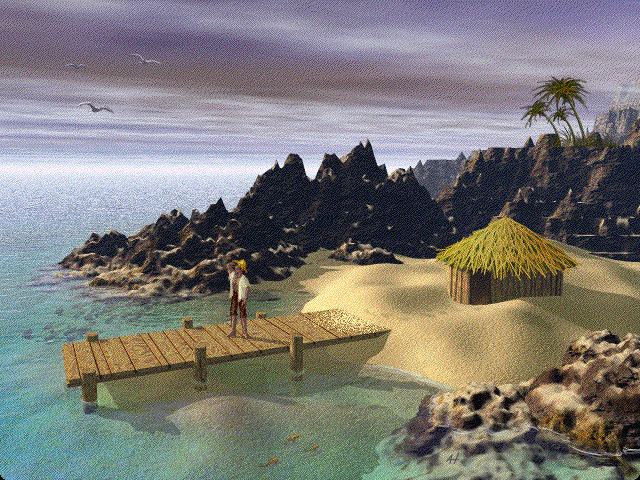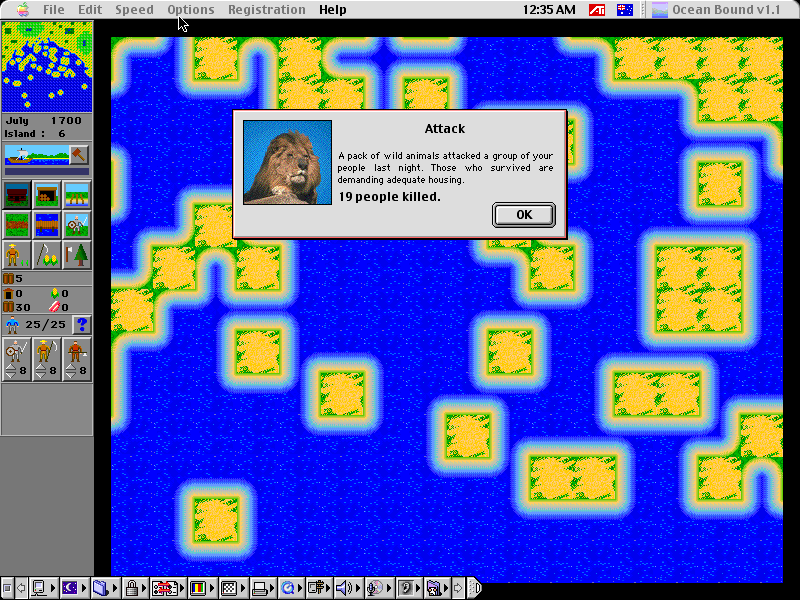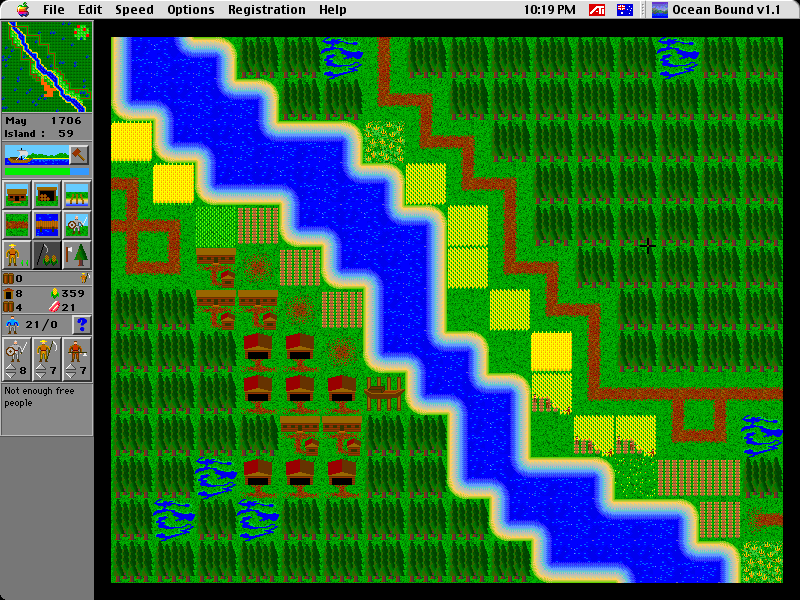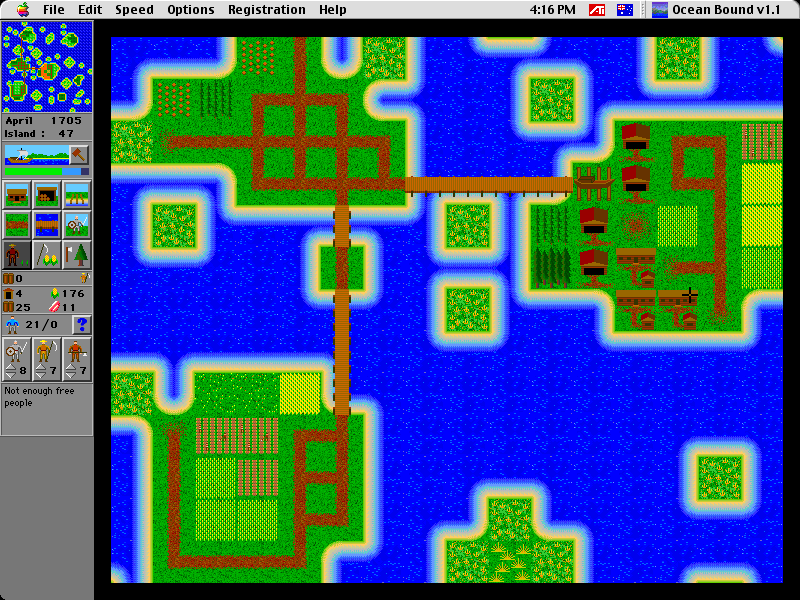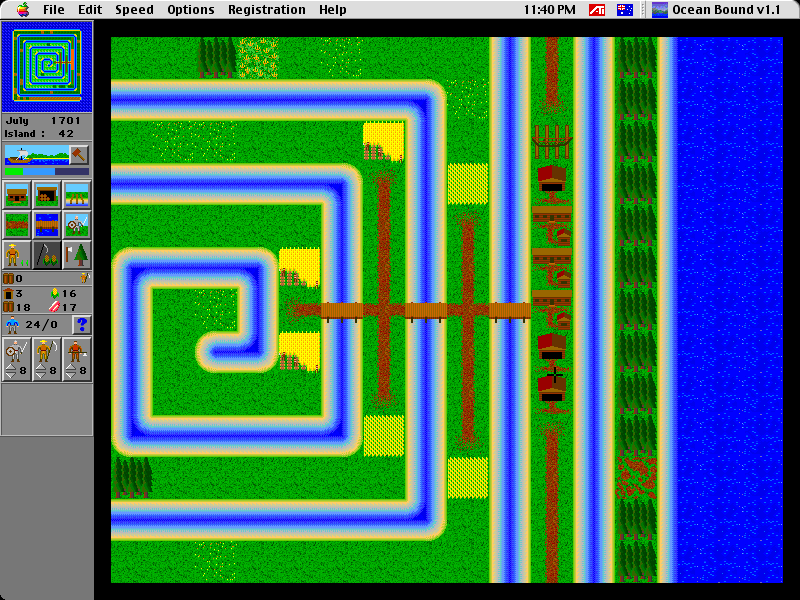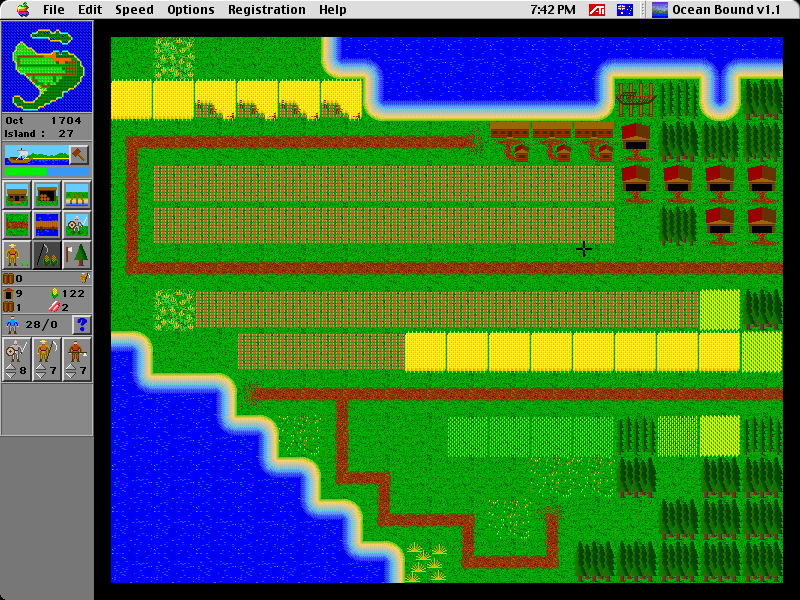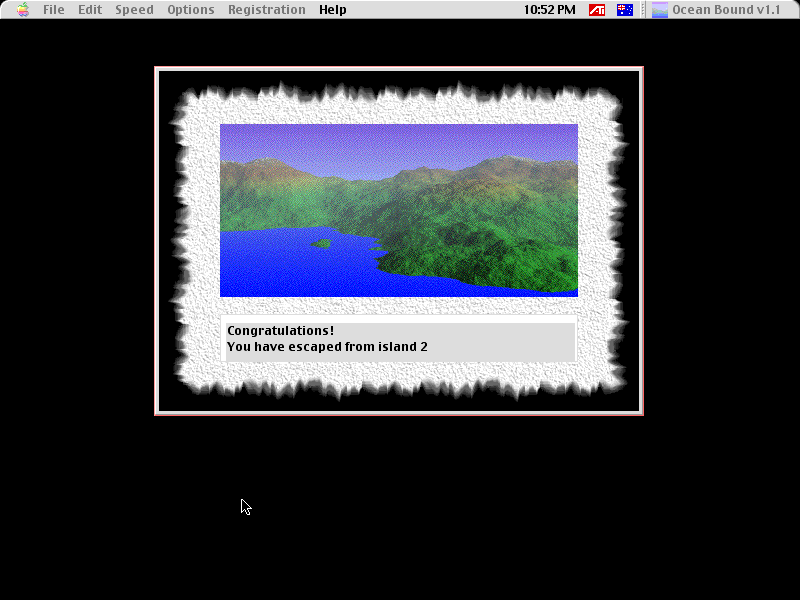Ocean Bound – Richard White/Spiderweb Software - 1998 - First time playing?: Yes!
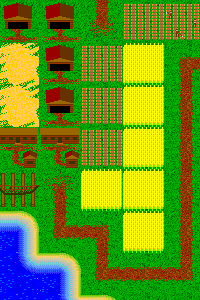 I like Ocean Bound. It's fun and satisfying, but it's also one of those games that does unfortunately wear out its welcome, not by doing anything wrong, but instead just by going on for a little too long when there just isn't enough depth or variety to keep it engaging for 60 whole levels. By ten levels in you'll have basically figured out the consistent strategy for how to win, and while that strategy will vary a bit from stage to stage, it's not quite enough to stop it feeling like you're using the same solution again and again.
I like Ocean Bound. It's fun and satisfying, but it's also one of those games that does unfortunately wear out its welcome, not by doing anything wrong, but instead just by going on for a little too long when there just isn't enough depth or variety to keep it engaging for 60 whole levels. By ten levels in you'll have basically figured out the consistent strategy for how to win, and while that strategy will vary a bit from stage to stage, it's not quite enough to stop it feeling like you're using the same solution again and again.
In short, Ocean Bound is a time and resource management focused strategy game. In order to have your castaways escape the island alive you'll need food to not die and wood to make a boat. These are your primary resources, although your castaways can also be seen as a resource, which we'll get into later. Starting out, you immediately have to build shelter in order to not get devoured by island lions overnight. “That's not the natural habitat of lions”, yeah well maybe there are just 60 lion infested tropical islands out there that remain uncharted on maps, you don't know for sure. A single hut can be built with 5 lumber, which can be used to keep ten castaways sheltered. Incidentally, if you've never used a Mac OS 9 computer before, a fun feature it has is that a text-to-speech voice will read out error messages if you idle on the error popup window for a while, with the text-to-speech saying something like “oh dear” or “drat” prior to reading the message out. I bring this up because Ocean Bound uses error windows to inform you if your castaways die, and I don't think the text-to-speech error messages had ever made me laugh as hard as they have in Ocean Bound. Hearing my computer say “It's not my fault; twenty people killed” in a deadpan robotic voice after a lion attack is absolutely hilarious..
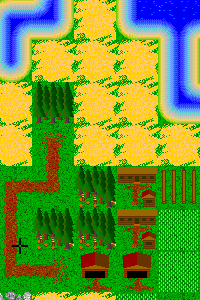 Once the shelter is taken care of, this leaves lumber and food. Your castaways start each level with rations; food salvaged from the shipwreck which doesn't replenish, but is enough to keep your guys alive until you set up a more sustainable food source. To do this, you'll order castaways to plant crops on parts of the island with flat, grassy land that are either next to your settlements or next to a road connecting to your settlement. Crops will grow over the span of a few in-game months, after which you can order your castaways to harvest them. Both planting and harvesting crops takes in-game time during which your existing food resources will be depleted, so it's important to keep on top of your farming production ahead of time. You do however also need storage sheds to keep your food in. These storage sheds can be built with 5 lumber, just like the huts, and each individual shed can hold up to 100 units of food.
Once the shelter is taken care of, this leaves lumber and food. Your castaways start each level with rations; food salvaged from the shipwreck which doesn't replenish, but is enough to keep your guys alive until you set up a more sustainable food source. To do this, you'll order castaways to plant crops on parts of the island with flat, grassy land that are either next to your settlements or next to a road connecting to your settlement. Crops will grow over the span of a few in-game months, after which you can order your castaways to harvest them. Both planting and harvesting crops takes in-game time during which your existing food resources will be depleted, so it's important to keep on top of your farming production ahead of time. You do however also need storage sheds to keep your food in. These storage sheds can be built with 5 lumber, just like the huts, and each individual shed can hold up to 100 units of food.
In order to get more lumber for your settlements, bridges to other islands and eventual escape boat, you'll need to assign lumberjack duties to your castaways as well. Tiles with trees can be harvested for lumber, a process which like farming takes in-game time and can only be done on tiles next to your settlement or a road connecting to your settlement. When you're done, that tile’s trees will be reduced to tree stumps, but they will eventually grow back, albeit very slowly. Before you can start building a ship you'll need to first build a shipyard, which costs 20 lumber. After the shipyard is built, you can then send units of lumber to the shipyard in increments of four. As long as the shipyard has enough lumber supplied, the castaways will continuously chip away at building the boat every day, even when they're assigned to farming or lumberjack duties. Once the boat is built, you've won the level.
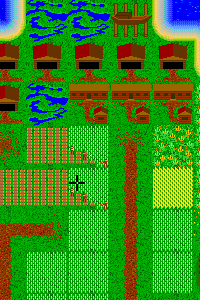 There's a few complicating factors to consider when building your settlement in Ocean Bound. First off, tiles that you repeatedly grow crops on will gradually become less fertile every time you regrow crops on them. They'll start out giving you 40 units of food and eventually end up only giving 10. Each castaway consumes one unit of food every in-game month, and the planting and harvesting usually takes at least two months, so it’s not sustainable. You'll need to move to planting on different tiles to keep your food supply up and high, but of course the tiles you can plant on are finite, so you'll want to escape the island as soon as possible so you're not forced to scrape by on 10 units of food per harvest. There's also the matter of road building to consider. Roads are built instantly at zero cost, but they do take up tiles, and any tile with a road on it can't be planted on, nor can trees be chopped down on it. As a result, planting roads is often cutting into the resources of the island as opposed to the resources you currently have on hand. Sometimes having a road cut through fertile land, as wasteful as it feels, is simply the better option to get to other parts of the island quicker or get to more numerous fertile tiles and trees.
There's a few complicating factors to consider when building your settlement in Ocean Bound. First off, tiles that you repeatedly grow crops on will gradually become less fertile every time you regrow crops on them. They'll start out giving you 40 units of food and eventually end up only giving 10. Each castaway consumes one unit of food every in-game month, and the planting and harvesting usually takes at least two months, so it’s not sustainable. You'll need to move to planting on different tiles to keep your food supply up and high, but of course the tiles you can plant on are finite, so you'll want to escape the island as soon as possible so you're not forced to scrape by on 10 units of food per harvest. There's also the matter of road building to consider. Roads are built instantly at zero cost, but they do take up tiles, and any tile with a road on it can't be planted on, nor can trees be chopped down on it. As a result, planting roads is often cutting into the resources of the island as opposed to the resources you currently have on hand. Sometimes having a road cut through fertile land, as wasteful as it feels, is simply the better option to get to other parts of the island quicker or get to more numerous fertile tiles and trees.
Another thing to consider is how many castaways you assign to each of these jobs. 1 to 8 castaways can be assigned to work on a single tile. Eight castaways will finish their job in one month, but the fewer castaways you assign to a single task, the longer they will take to complete it. However, assigning fewer castaways to single jobs can also allow you to multitask better, since that leaves you with more free castaways to give different tasks to. If for instance, a level has you start with 21 castaways, if you assign eight castaways each to farming on a couple of tiles, that will leave you with six castaways without jobs, that you could then assign to a lower priority job. Alternatively, you could assign all of your work forces in groups of seven, so they're all evenly spread and the delay is less significant, only being one castaways short of the max possible speed.
The final job you can assign your castaways is garrison duties. Some islands have villages of natives on them who don't care for trespassers, and as such will kill your castaways in retaliation if you work close to their settlements. Garrisons allow you to assign units to essentially perform guard duties at the native settlements and keep them in line. This probably sounds gross and that's because it is, so I avoided using this function for my entire playthrough because I didn't want to roleplay as Columbus. Here's the level very clearly designed to bait you into using garrisons beaten without trespassing. No problem, easy.
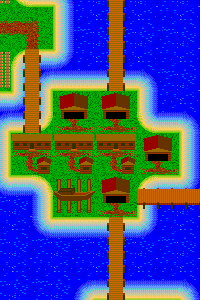 As you can see, there absolutely is plenty of strategising to consider in Ocean Bound, but ultimately every level does boil down to the same basic objective; get as much food and lumber as quickly as possible. All of your road building and settlement forging is ultimately all in service of just accumulating as much of those two resources as possible, and once that clicks the game starts getting dull. Build roads that give access to the island's resources and then get yourself settled in the routine of plant crops, chop trees and harvest crops. Repeat the process until you have enough lumber to finish the boat, after which just focus entirely on farming. Some levels mix things up by being set across a multitude of small islands which your castaways can only travel between by building wooden bridges to cross the islands, which also naturally requires more lumber, but that's about it. By strategy game standards, the levels are quite short, but also still long enough to get fairly tedious when all that's left to do is just keep planting crops again and again.
As you can see, there absolutely is plenty of strategising to consider in Ocean Bound, but ultimately every level does boil down to the same basic objective; get as much food and lumber as quickly as possible. All of your road building and settlement forging is ultimately all in service of just accumulating as much of those two resources as possible, and once that clicks the game starts getting dull. Build roads that give access to the island's resources and then get yourself settled in the routine of plant crops, chop trees and harvest crops. Repeat the process until you have enough lumber to finish the boat, after which just focus entirely on farming. Some levels mix things up by being set across a multitude of small islands which your castaways can only travel between by building wooden bridges to cross the islands, which also naturally requires more lumber, but that's about it. By strategy game standards, the levels are quite short, but also still long enough to get fairly tedious when all that's left to do is just keep planting crops again and again.
There's still satisfaction in spite of that. Ocean Bound eventually turns into a puzzle game once you've cracked the primary strategy of how to win the game, with you figuring out the most optimal roadways to best exploit the island resources via. The difficulty does eventually at least slightly pick up by the last quarter of the game. It's still not particularly hard, but later levels do require a bit more thought. The spiral shaped island was a highlight for me. I started it expecting it would just be a gimmick level defined more by the aesthetic than the strategy, only to quickly realise the second I actually thought about playing the level the unique challenges it provides due to the long line of tiles making up the spiral being only one tile wide, this making it being impossible to build roads on without destroying the island resources which you need to win, thus requiring more creative and unconventional bridge usage. There's also a few levels that have all the trees on a separate island to all of the fertile planting ground, thus requiring you to save up lumber quickly enough to build a bridge between the two islands and still have time to plant and grow the crops you need to sustain your castaways for the rest of the level. It's fresh and tense the first time it happens, but quickly becomes routine since any time a later level uses that same gimmick you'll be using the exact same solution on it.
However, a large chunk of the levels in Ocean Bound are so massive, filled with so much open space for planting and more trees than you'd ever need, all on a single island with no water to cross or native villages to build around. These maps have zero challenge to them the second you've learned the basics, and that's where the tedium sets in. Primarily, the challenge of Ocean Bound is based around resource management, not only of food and lumber but also castaways and time, but the game frequently gives you so many resources that you'll never even need to think about such management as much as you're just clicking on the tiles you can farm or chop wood on like clockwork until you have a stockpile of food higher than the game can even count, and there's still several in-game years before the escape ship is built. These kinds of levels should exist, of course. They're important for teaching the player the mechanics in a safe environment before gradually ramping up the complexity and tighter resources of later levels, but the difficulty curve is wonky and simple levels like that show up bizarrely late into the game, long after more challenging levels have already been completed by the player.
It's definitely a more shallow game that it appears at first glance, but I still think Ocean Bound is fun for what it is and enjoyable as a light pick-up-and-play strategy game to play a level of here and there, as opposed to the usual more time-consuming and demanding wargames out there. Since I refuse to review games I don't finish and I need to finish games fairly quickly in order to keep up with my weekly review schedule, I pushed myself to play through every level back to back which is not exactly the best way to engage with Ocean Bound. Fortunately, my situation is unlikely to be how most engage with games, so if you're looking for something casual and have access to a machine or emulator that can play it, give Ocean Bound a shot.
- Page written by MSX_POCKY, 4th July 2025
